The upkeep of a deck is challenging. It requires frequent washing, coloring, and resealing. Homeowners take on these tasks because they think they are easy to complete.
Therefore, if you’re a DIY enthusiast looking for solutions to questions like “How should you know if the deck is dry to stain?” The solution needs to be clear-cut and simple.
You have three easy options for determining the moisture level of your deck wood after power washing. Using a moisture meter, you can measure it; the measurement should be lower. Another method is to perform the condensation test, which states that there should be no condensation after placing the wood end in a bag for a few hours. You can also check to see if water beads develop when water is sprayed onto decks.
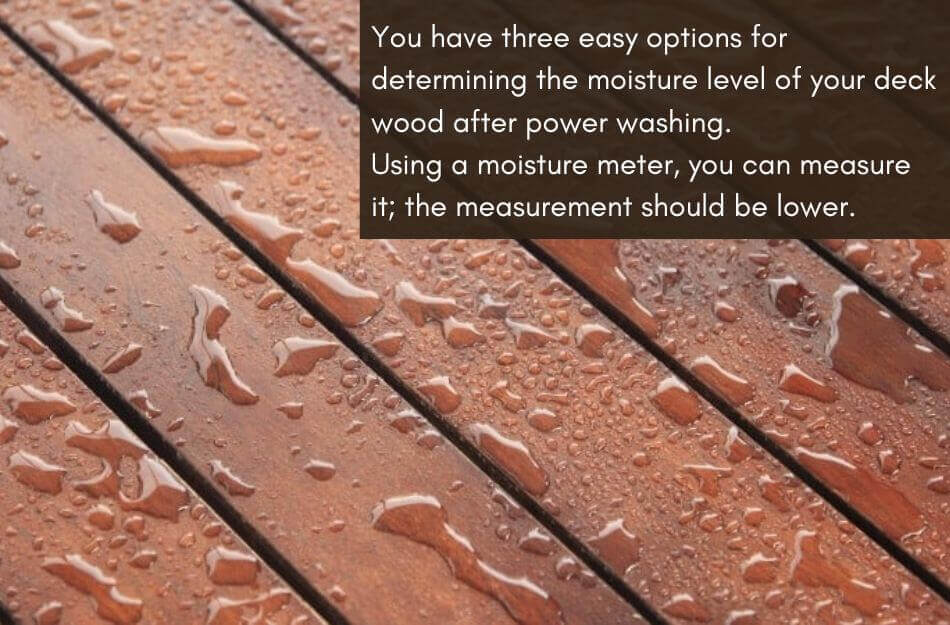
You must assess the degree of moisture in your wood planks to ensure a longer lifespan for the deck, improved staining results, and reduced repair costs.
This guide is meant to assist all do-it-yourselfers who want to stain precisely their vintage deck floor. Everything you should know before coloring your deck is written in this article.
Using any of the solutions mentioned here, you can prevent the factors causing moisture on the deck. Therefore, reading it will enable you to flawlessly paint your deck.
Table of Contents
- 1 Typical Drying Time
- 2 Indicators that Your Deck is Dry Enough for Staining
- 3 How Long After A Power Wash Should I Wait Before Staining?
- 4 How Can You Determine If A Wood Deck Is Damp After A Power Wash?
- 5 What Happens When Wet Pressure Treated Wood Is Stain?
- 6 Drawbacks of Trying To Stain A Wet Deck
- 7 When is The Ideal Time to Stain a Deck?
- 8 Can a Damp Deck be Stained?
- 9 How Long Does a Deck Take to Dry after Power Wash?
- 10 How to Shield Your Deck?
- 11 How Long Does it Take for the Deck Stain to Dry?
- 12 Can you Stain a Deck before it is Fully Dry?
- 13 What Takes Place If The Wood Is Not Cure Before Staining?
- 14 What Will Happen if it Rains After you Stain your Deck?
- 15 Why Is The Previous Stain Needed To Be Scraped Off Before Re-Staining?
- 16 How Can I Clean up My Deck of Algae Growth?
- 17 How Can I Tell if Wood is Prepared for Staining?
- 18 What Occurs if a Deck is Stained before it Dries?
- 19 Final Words
Typical Drying Time
Your deck needs to cure for 48 hours before staining. The rule of thumb derived from this waiting time applies to both seasoned woodworkers and novices.
The weather when you are working on your deck impacts the usual time. When working in your carport or a shaded area where the sun hardly shines, give your deck 72 hours to dry.
The drying process is influenced by rain, but less than it is during a typhoon. More than 48 hours are needed. The procedure is slowed down by high humidity.
The procedure can only be stopped in the summer. Cold conditions prolong the process. Other sun and direct heat accelerate the procedure to at least 24 or 48 hours.
If it rains, cover the surface with a cloth or do your job in a covered area. If you pressure wash your deck, use a damp towel to remove any water accumulated on the surface.
If you don’t, the water will pool in one spot. When painting your deck, that will have an impact on the area.
Also Read: How Often You Should Stain Your Deck?
Indicators that Your Deck is Dry Enough for Staining
Before conducting a test, check the wood clearly to determine whether the deck is dry on its outermost layer. There shouldn’t be any oedema or puffiness in the wood.
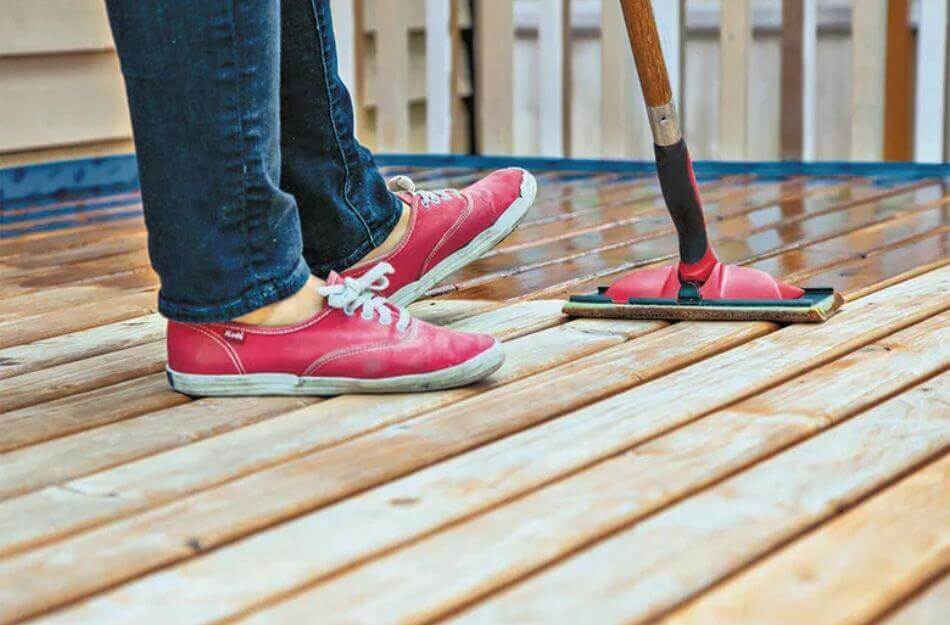
Nothing on the top should be soft. Give your deck one more day if you need more convincing by the outcomes your eyes show you.
If the wood absorbs the water after being exposed for 10 minutes, get set to stain. The wood requires more drying if the water beads or collects on the surface.
How Long After A Power Wash Should I Wait Before Staining?
Give your deck boards two days to dry after power washing. After a pressure wash, water typically evaporates within that amount of time.
Your deck requires a suitable period to dry fully. Lack of drying time will result in moisture in your wood, which will encourage the development of mold, fungi, and algae.
Thereby ruining your wood. Thus, you must delay the shortest time possible before staining your deck. Professionals have standardized this time frame after appropriate drying circumstances.
The deck has to face the sun, and it must be a warm environment. On the other hand, if your deck is drying in a shaded area, you will need to allow it more time to dry.
The wet platform might be dry in three days. The temperature of the day, however, affects time projection. Moreover, you will need more time if there is a storm.
Before allowing it to dry freely in the sun, soak up any water on the deck’s surface. When water is left on a few spots, the wood planks become moister than the entire surface.
You can also use your foot to evaluate the surface’s moisture content to ascertain the time needed.
Therefore, the time it takes for your wet deck to dry relies on variables like temperature, air quality, and weather. Therefore, be careful to power wash in a hot, dry atmosphere. It will help you save a ton of time.
See Also: Oil Vs Water-Based Deck Stain: What’s Best To Use?
How Can You Determine If A Wood Deck Is Damp After A Power Wash?
After allowing your deck the ideal amount of time to dry, you cannot stain it. You must assess the wood’s degree of dampness; otherwise, you risk sealing in the moisture and having to start over.
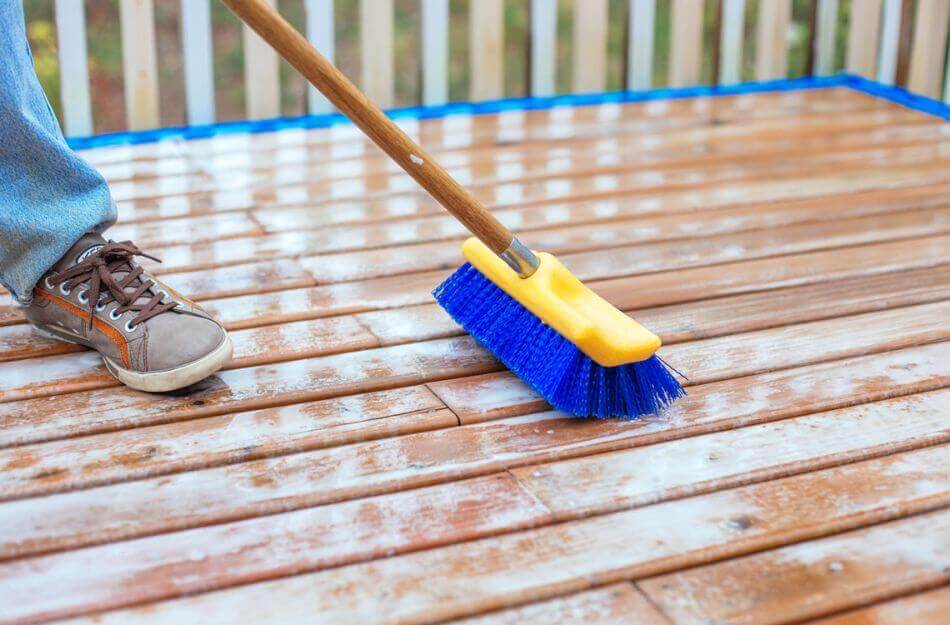
As not only depletes the vitality of the deck but also costs you more money.
For instance, you stained your wood while leaving moisture inside. Your deck paint will quickly flake and peel off, costing you more money to repaint.
The expense will increase if wood planks are prematurely destroyed and must be replaced.
Determining whether your deck is dry enough for staining would be best. Below are a few techniques for determining whether your deck has moisture. Following a power wash, there are three ways to check the level of moisture on the deck.
Moisture Meter Testing
One effective method to determine if the deck is dry enough for staining is to examine the moisture level with a meter. The moistness of the wood is monitored by a moisture meter.
You must use a moisture meter to examine the deck timber at various points along the wooden platform. For staining, a 19% or less moisture content is suitable.
Measuring With A Bag Covering
Another technique for determining the moisture content of wood is to wrap the edge in a dark garbage bag and expose it to light for a couple of hours. Immediately after four to five hours, open the polybag.
The wood needs to be dry enough to stain if condensation exists. No, condensation indicates it is sufficiently dry to stain.
Testing With Water Splashes
You can use the third technique to test whether your wood is appropriate for staining by sprinkling water. If water beads start to develop on the lumber’s surface, it’s still too wet to stain or paint.
But if the water rapidly permeates the deck planks, it is prepared.
Don’t Miss: Deck Vs Oil Stain: Find Out The Differences
What Happens When Wet Pressure Treated Wood Is Stain?
Pressure-treated wood will not properly absorb the stain if you stain it while it is damp. To avoid the structure collapsing, let your wood dry before staining. Your treated wood will appear more appealing and protected if you stain it.
Even if you stain the wood, it will likely rot from the inside because it is still moist. Due to the retained moisture, some wood begins to rot.
Since you are exposed to the dry outside surface, maintaining wet pressure-treated wood can be difficult. Your wood is vulnerable to rot and decay as long as it is moist.
The wood absorbs moisture during shifts in temperature and then freezes. The timber is destroyed when it breaks when it freezes.
Though the process is gradual, because it is repeated, it causes destruction. Wet-treated timber cannot retain its natural color when stained.
The wood becomes discolored as a result. Ultimately, the stain no longer offers the protection it was meant to. After the wood dries, quickly re-stain the surface.
Drawbacks of Trying To Stain A Wet Deck
The final result will differ from what you expected if you stain a deck while it’s still wet after pressure cleaning. As a consequence, you won’t get the desired outcomes.
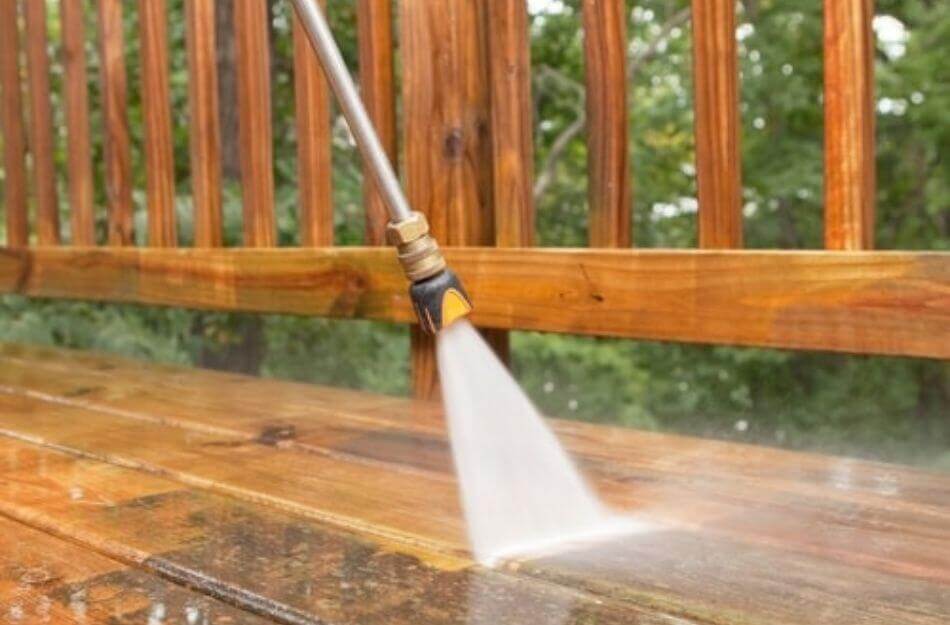
Oils and colors are frequently blended to create board-penetrating wood paints.
As a result, staining damp deck boards won’t result in enough absorption, giving your deck an uneven appearance. The drawbacks of staining a wet deck are as follows.
Mold Growth
Microorganisms like algae, fungi, and mildew develop on any damp surface. Staining locks the collected water within the wood without properly drying the wood.
This water provides the moisture that moss, mold, and algae need to develop. Therefore, the wood’s moisture-sealing causes unwelcome moss, fungi, and mildew growth.
Related: Vapor Barrier Under Deck: The Best Moisture Barrier Options
Flaking
Additionally, if you stain a damp deck after pressure-treating the wood, it won’t adhere to the surface precisely. Additionally, staining a wet hardwood deck will result in your stain cracking and flaking off.
Therefore, you will soon need to redo the complete painting task. Let it air dry before painting to prevent the stain from peeling. Wood staining enhances the look of your deck while also preserving it.
Wood Self-Deterioration
Wood that has been stained is likely to begin to rot from the inside out due to the dampness left inside. Due to water absorption in the pores and areas between deck planks, some wood degrades more rapidly than others.
Maintaining a deck after washing is difficult due to exposure to the weather and other environmental factors.
Wood accumulates water and freezes as the weather changes, making it susceptible to gradual decay as long as it retains moisture. Cracks caused by the freezing harm the wood.
Less Durability
The deck paint layer stays thin when your floor is wet. Water has filled the pores in the deck wood, preventing it from absorbing the oils in the stain.
Deck paint will become unstable and less durable and start peeling sooner. Additionally, UV shielding is reduced by thin paint applications. So, give the deck wood time to dry if you want to safeguard it effectively.
Color Fading
Because of thin coats of stain applied to the wood, the deck paint’s color starts to fade because of the sun’s UV radiation.
The pigments of the staining liquid did not penetrate the wood because your wood boards were damp. Because of the sun’s damaging UV rays and the severe weather, it began to diminish.
When is The Ideal Time to Stain a Deck?
Without squandering time, stain the fresh deck as soon as it is installed. Therefore, dirt and dust have less time to accumulate on the wood. Additionally, you might need it to be as sterile and dry as feasible.
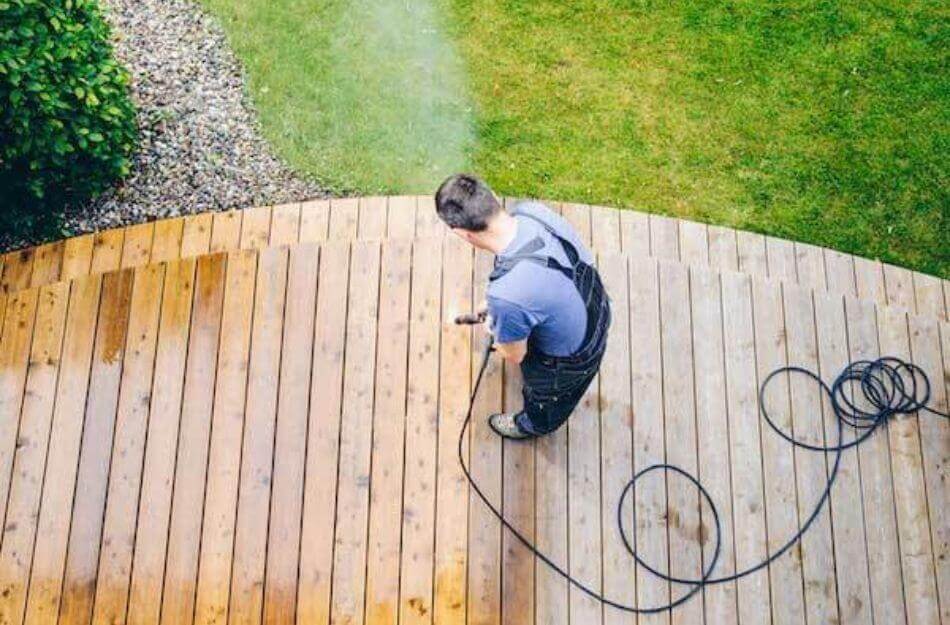
To ensure that you have dry weather and that it won’t rain within a week, consult the weather forecast first. Try to achieve sweltering, dry weather (but not scorching). Anything between 50°F and 90°F is ideal.
If the humidity is higher, your damp deck and stains will take longer to dry. In other words, it shouldn’t be too hot or too cold. A dry, warm day is the best weather condition for staining a deck space.
Both humidity and breeze should be absent. 10 to 35 degrees Celsius should be the temperature of the light. While the sun is fiercely overhead, you shouldn’t stain the flooring.
The stain could not penetrate the wood because it would dry out too quickly.
However, it would help if you didn’t paint or stain pressure-treated wood immediately after installation because the same chemicals that shield the wood from dampness and insects also limit how well paint or stain will penetrate the wood.
If the deck has been exposed to light, wait for at least 42 to 50 days. If it is in the refuge, wait 28 weeks.
Can a Damp Deck be Stained?
A damp deck shouldn’t be stained. Start fresh by removing the previous or wet stain. The surface becomes uneven when a damp deck is stained. The wood surface won’t accept the wood stain properly.
How Long Does a Deck Take to Dry after Power Wash?
Deck takes 48 hours to dry after power wash, as it is a general rule for DIY deck constructors, residents, and expert contractors is that a freshly washed deck needs about 48 hours to dry out completely.
How to Shield Your Deck?
Applying a brand-new layer of deck paint or stain is the most effective way to shield your decking and wood from harm as the weather changes and a simple way to liven up the outside area for a fun end-of-season party.
How Long Does it Take for the Deck Stain to Dry?
The typical drying time for 100 square feet of wood paint is four hours. A complete day is advised for drying. Deck stains require time to cure.
You will have to wait even longer in cooler climates or during heavy humidity.
Clean your toes and go barefoot if you need to use your deck but need clarification on its readiness. It lessens the possibility of leaving paw impressions.
Can you Stain a Deck before it is Fully Dry?
Letting the wood deck dry completely is crucial to prevent water from getting trapped under the stain.
48 hours should be sufficient for the wood to reach the required state for staining under ideal drying circumstances. Decks that receive little sunlight should have an additional day to dry out.
What Takes Place If The Wood Is Not Cure Before Staining?
Wood swells and shrinks because of absorbing and losing wetness. It suggests that working with wet wood results in distortions, less effective lubrication, fractures, and form changes.
Additionally, moss and fungi may grow, therefore.
What Will Happen if it Rains After you Stain your Deck?
If it rains within forty-eight hours of stain application, the water will seep into the board’s pores and try to push the color out of place.
If you stain the deck immediately and it starts to rain, the stain will crumble and flake off. If your paint has been drying for more than 48 hours, it might not happen.
Why Is The Previous Stain Needed To Be Scraped Off Before Re-Staining?
The new paint’s tint can vary depending on the hue of the old stain. Your deck will appear dark after the staining if it has already flaked off in some spots.
Scraping the previous stain layers before reapplying is ideal for achieving better outcomes.
How Can I Clean up My Deck of Algae Growth?
Your wood deck can be cleaned of algae in several ways. Bleach is the most common option, but using it on your deck could change its color and even harm the metal bolts holding it together.
The Occupational Health and Safety Administration does not advise using bleach to remove mildew and algae. Use pure white vinegar instead, though.
It is a well-liked natural cleaner that can be used inside and outside. Mix one gallon of water with one tumbler of white vinegar, then scrape the floor to eliminate algae, mold, and mildew.
How Can I Tell if Wood is Prepared for Staining?
Try the sprinkle test to see if wood is cured enough to stain. If the wood absorbs water within 10 minutes of application, plan to stain the wood as quickly as possible.
The wood requires more time to dry if the water clumps up or collects on the surface.
What Occurs if a Deck is Stained before it Dries?
Wood absorbs stains and oils the best when it’s cold and dry. Within 48 hours after applying a treatment, the water will seep into the timber and attempt to remove the stain if it rains.
Instead of a uniform, smooth covering, this may result in a blotchy, flaky appearance.
Final Words
Staining is necessary to maintain a deck and keep it in excellent condition for many years. However, applying the stain incorrectly could harm the condition of your deck timber and increase your expenses.
Therefore, you must perform one of the three methods mentioned in this article to test your deck for moisture. After staining the deck, not gauging the dampness will have unfavorable effects.
Additionally, it will end up doing more damage to your surface than good. Painting a deck is not an easy task. Your floor can look beautiful with the proper drying, temperature, and a high-quality stain.
Recent Posts
Although deck sealing may not be at the top of your summer to-do list, you shouldn’t put off a task.One such deck that channels the opposite of the lively and enjoyable vibe you want from an...
Any home would benefit from having a deck because it adds more area for socializing, relaxing, and outside activities.Garden decking that has been properly polished can be elegant and lovely. It...
